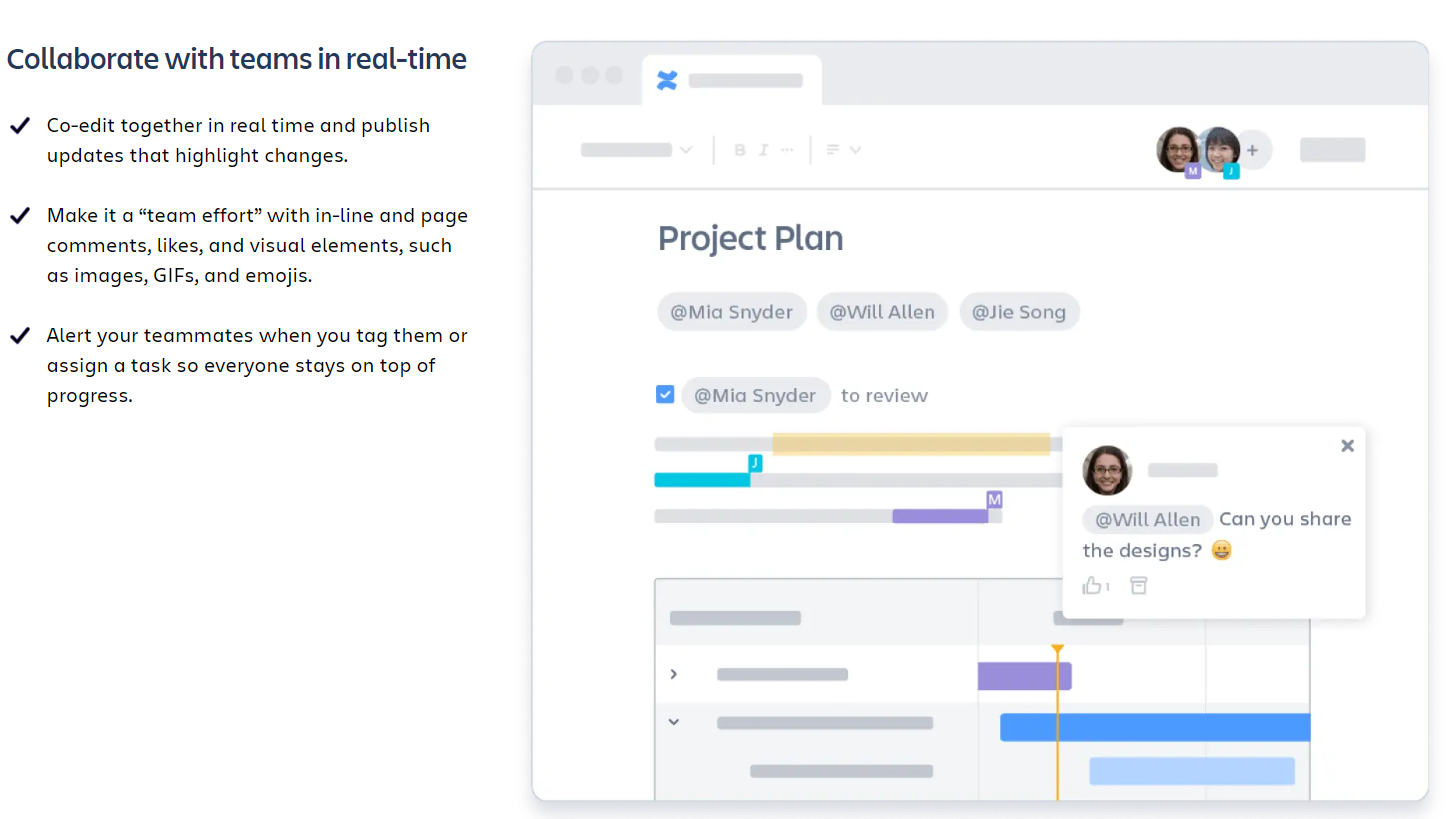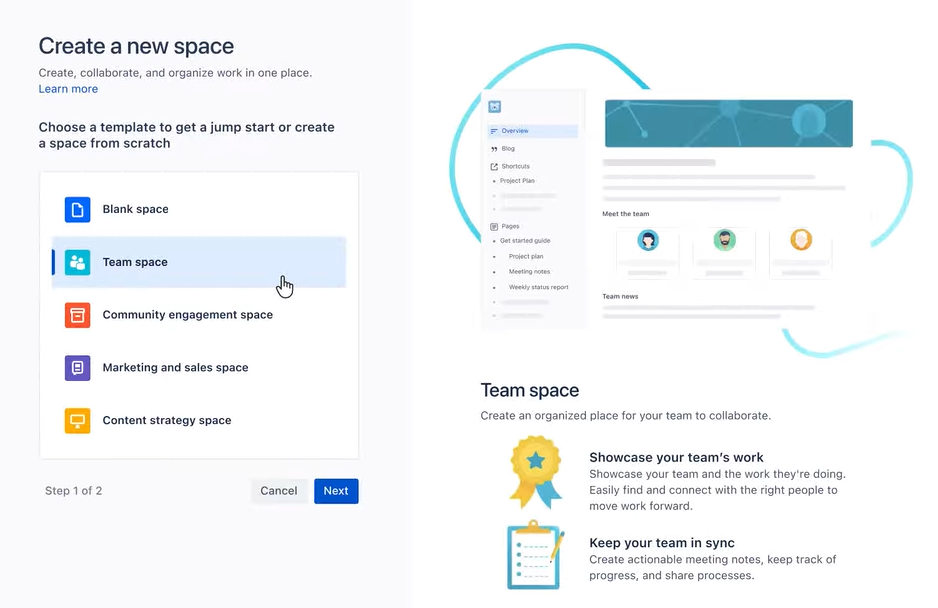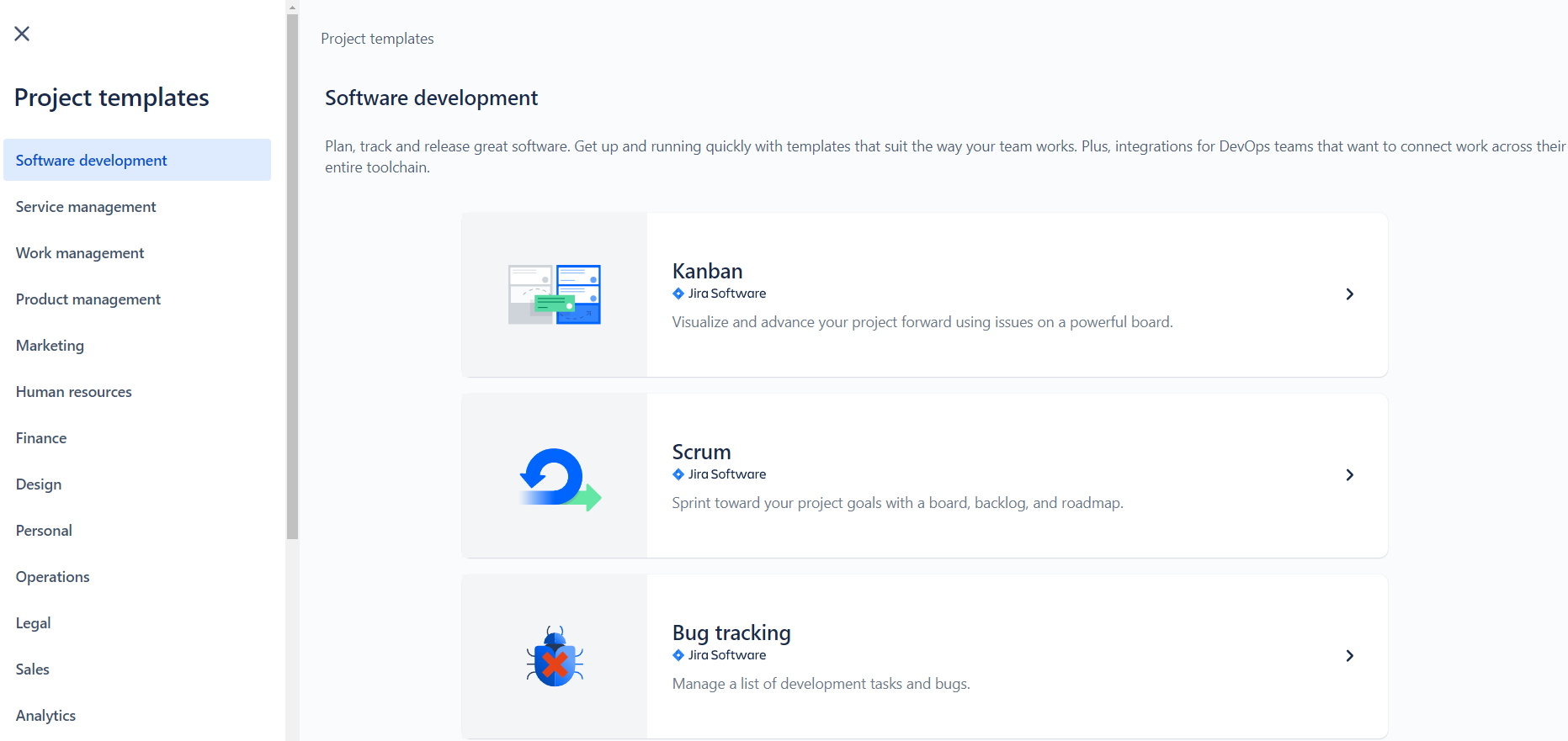Not sure if your company should use Confluence or Jira, or both? This ultimate comparison of Confluence Vs. Jira will show you the right path to successful project and content management!
Both Confluence and Jira are part of Atlassian’s product suite. However, Confluence is for content and idea collaboration, whereas Jira is for issue-tracking and project management (with modifications).
In this article, I will present a detailed user review of both tools, analyzing their respective advantages and disadvantages. This analysis will aid you in determining whether you require Confluence, Jira, or a combination of both for your business.
Confluence: An Overview

Unify your work, collaboration, and organization in one central hub with Confluence. It brings together knowledge and teamwork in a central and easily accessible workspace. The dynamic pages provide an ideal environment for creating, capturing, and collaborating on projects and ideas.
By utilizing spaces, your team can structure, organize, and share work, ensuring every team member has visibility into vital information and institutional knowledge required for their best performance.
Teams of all sizes and types can use this content collaboration software. It caters to those engaged in critical, high-stakes projects that demand strict adherence to practices. Also, business teams seeking a platform to foster team culture and promote open, authentic interaction should use Confluence.
With Confluence at your disposal, your team can make informed decisions swiftly, achieve alignment, and enhance productivity through collaborative efforts.
How Does Confluence Work?
To understand the working process of Confluence, you must know where the tool operates and its key elements.
Confluence Hosting
You can host Confluence on a Confluence Data Center based on Azure or AWS if you want private cloud operations. If you are okay with the public cloud, then you can simply sign up for the cloud-based Confluence solution.
Finally, if your content is highly sensitive and you want the internet-less solution, you can host Confluence on an on-premise server with intranet accessibility.
Key Elements of Confluence
#1. Pages
Confluence provides a platform where your content thrives within dynamic Pages. These serve as living documents on your Confluence site. These pages can be created for a wide range of purposes, including project plans, meeting notes, troubleshooting guides, policies, and more.
To facilitate your content creation process, Confluence offers a variety of templates that allow you to craft visually appealing pages for almost any type of content. In the event that a template specifically tailored to your desired content is not available, you always have the option to begin with a blank page and customize it according to your needs.
#2. Spaces

Pages within Confluence are organized and stored in Spaces. These serve as collaborative workspaces. Spaces allow you to keep your content structured and easily accessible. It is recommended to group related content within the same space, although you have the flexibility to create as many or as few spaces as necessary for your team.
For instance, a marketing team may choose to consolidate all their work in a single space, with dedicated pages for each campaign.
Conversely, another team might opt to have separate spaces for individual campaigns. Each space within Confluence features an overview or homepage, as well as a blog, facilitating seamless sharing of updates and announcements with the entire team.
#3. Page Trees
A Page Tree provides a hierarchy of all Spaces and Pages for a project on Confluence. It might be pretty easy to manage blog posts, images, and links for a coffee beans website publishing project. But, if you are a big media with five to 10 or more websites under one umbrella, then content management becomes a chaotic job. Confluence, and especially Page Trees, make the task smoother.
For example, Acme Media publishes 10 different websites on tech, gaming, fashion, travel, etc. Then, it can create an Acme Page Tree under which it will organize all the content for different departments in Spaces and different blogs on dedicated Pages.
Usage of Confluence

- Serves as a team workspace for content creation, collaboration, and approval.
- It offers a dynamic content creation workspace so the creator can modify the content, and the whole team has access to the latest version of it.
- You can create a standard operating procedure for product or software development on Confluence and update it regularly. Your products and development teams will deliver consistent work, always.
- Also, you can integrate it with other Atlassian products, such as Jira, to enhance your teams’ issue-tracking capabilities.
- The tool is best suited for collaborative brainstorming and ideation.
Reasons for Businesses to Use Confluence
- The primary use case of Confluence in business is to create an accessible knowledge base.
- It also helps business teams to collaborate on the content creation journey seamlessly.
- Confluence offers extra layers of security for digital data on the internet and intranet.
- It is easy to update software or mobile app content using Confluence and its version tracking system.
- Businesses that use Jira Software mostly use Confluence since this is the native CMS for all Atlassian apps.
Limitations of Confluence
- It is not professional project management software.
- Its collaborative features only work over an Internet or Intranet network. Absolutely no offline functionalities.
- Pages formatting is a challenging task.
- Its mobile app has very few functionalities than the web version.
Jira Software: An Overview

Jira Software is the leading agile project management and issue-tracking tool. Globally software and product development teams confidently plan, track, release, and support exceptional products, services, and software on this tool.
Serving as the ultimate source for your entire development lifecycle, Jira Software equips autonomous teams with the necessary insights to swiftly progress. Also, it helps teams remain connected to overarching business objectives.
Whether utilized for managing straightforward projects or fueling DevOps practices, Jira Software simplifies the process of advancing work, fostering alignment, and facilitating contextual communication within teams.
How Does Jira Work?
Jira Software caters to a wide range of agile project management methodologies essential for software development. Whether you require agile planning or seek fully customizable Scrum and Kanban boards, Jira equips you with the necessary tools to estimate, report, and measure velocity.
It offers workflows specifically designed to align with your frameworks, ensuring seamless integration and adaptability.
Its major elements that you will use during issue creation, tracking, and disposal are:
- Boards: Agile, Scrum, and Kanban boards for issues and tasks.
- Timeline: Monitor work progress and upcoming bottlenecks or dependencies using a Gantt chart-like timeline for the whole project.
- Task Update Notification: Jira allows you to create and customize notification schemes. These schemes define who receives notifications and for what events. For example, you can set up a scheme to notify the issue assignee and reporter whenever an issue is updated.
- Insights: Create functional reports on Jira to take proper measures to speed up a project running behind schedule.
- Integrations: Sync third-party business apps with Jira to bring content, design elements, codes, charts, data analytics, etc., within Jira Software.
Usage of Jira

- For Scrum and Kanban boards based on the Agile methodology of software or product development, various teams use the Jira Software.
- Teams can configure Jira for any project, task, and work management.
- Jira CI/CD integrations are suitable for software lifecycle management.
- Jira Software is the core system of Atlassian’s open source and integrated toolchain also called the Open DevOps.
- Customer support, sales, and marketing teams can use Jira to suit their respective functionalities.
Reasons for Businesses to Use Jira
Primarily, software development teams use Jira since this Atlassian product has proven its superiority over any other similar applications. Jira is the gold standard for issue tracking, service management, program code debugging, CI/CD, etc. Other major reasons behind Jira’s wide acceptability are:
- Jira Software comes with real-time templates for issue and advanced task tracking. So any small to medium business can easily set up and start managing projects on Jira.
- With this application, one business can manage several departments like product development, customer service, product management, human resources, marketing, finance, operations, sales, legal, and facilities.
- Jira Software scales with businesses as they grow and evolve. It can support small teams working on single projects as well as large enterprises managing complex portfolios.
- It also offers powerful reporting and analytics features, enabling businesses to gain insights into overall project health. These insights assist in making data-driven decisions and identifying areas for improvement.
- Jira Software integrates with 3,000+ business and creative apps. The list includes development and collaboration tools, version control systems, and continuous integration/delivery platforms. So you can streamline workflows and enhance project productivity.
Limitations of Jira
- Beginners may need a week or two to learn the Jira app before they can productively operate the tool
- If you are already using a Jira alternative, then migrating to Jira is a challenging task. You may not find an easy way to onboard all the Agile development, debugging, and service management project portfolios to Jira.
- According to many industry experts, there few important integrations are missing.
- Non-IT industry experts believe that Jira requires an extensive overhaul if they need to manage non-IT or non-software product development projects.
- Jira mobile app lacks advanced features to monitor issue-tracking projects from smartphones or tablets.
- If you are not using a related Jira Software template to set up a project, you may require weeks to set up a functional project board on Jira.
- Jira Cloud Enterprise and Data Center versions are costlier than other solutions.
Confluence Vs. Jira: The Similarities
Find below a holistic view of the similarities between Confluence and Jira:Features Confluence Jira Developer Atlassian Atlassian Hosting options Cloud, data center, and on-premise Data center and cloud User Interface and Experience Similar to all Atlassian apps Same as other apps from Atlassian App versions Cloud, smartphone, and tablet Cloud, tablet, and smartphones Task assignment Available Available Dashboard Available Available Cloud storage 2 GB, 250 GB, and Unlimited 2 GB, 250 GB, and Unlimited Templates Available Available
Confluence Vs. Jira: The Differences
Here is an effortless table to pinpoint the fundamental differences between Confluence and Jira:Features Confluence Jira Major elements You can not create software documents on Jira, but you can attach them from Confluence or other apps Boards, Timeline, Insights, Integrations Tasks There are no tasks Tasks are Issues like Epic, Task, Story, Bug, and Sub-task Collaboration You can not create software documents on Jira, but you can attach them from Confluence or other apps Only Jira Software license owners or free plan users can collaborate with you on your Jira projects. CMS functionality Yes No Software documentation Yes You can not create software documents on Jira but you can attach them from Confluence or other apps Content or project timeline view No Yes Real-time collaboration on objects Extensive Limited Data analytics and reports Limited to content Extensive data analytics and reporting Access control Extensive options Limited access controls Agile, DevOps, and Scrum Limited support Extensively supported Active directory integration None Available Edit documents, text, etc. Possible Not possible without integrations Calendar management Available Not available without integrations Automated workflow Not possible Extensively possible with coding and no-coding
Author’s Note
By now, you must know that Jira Software and Confluence serve two completely different purposes. You can use Jira to track software-related issues and projects.
On the other side, Confluence is an app where you create content with your team collaboratively. Furthermore, add company policies and guidelines on a Confluence Page so your team members can follow those.
Now, if you have access to Jira and Confluence both, you can club them to extend each other’s functionalities. If you only have Jira and your business doesn’t extensively deal with content, the Jira file hosting system is sufficient for you.
But, if you have Confluence and need to manage projects professionally, you need Jira Software or Jira Work Management app.
Atlassian is a leading software development company for business apps that make work easier, more exciting, and more profitable. Jira and Confluence are the most widely used business apps from Atlassian.
Many DevOps, Agile, and Scrum teams use Jira issue-tracking and service management software to put service requests in a workflow for transparent tracking. These teams also use Confluence for the above and other projects to collaborate on internal documents, files, etc.
Related Articles
You can trust Geekflare
Imagine the satisfaction of finding just what you needed. We understand that feeling, too, so we go to great lengths to evaluate freemium, subscribe to the premium plan if required, have a cup of coffee, and test the products to provide unbiased reviews! While we may earn affiliate commissions, our primary focus remains steadfast: delivering unbiased editorial insights, and in-depth reviews. See how we test.

